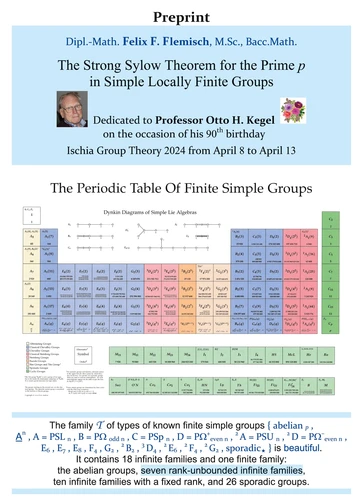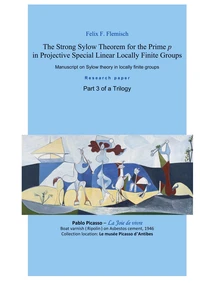The Strong Sylow Theorem for the Prime p in Simple Locally Finite Groups. Dedicated to Prof. Otto H. Kegel on the occasion of his 90th birthday
Par :Formats :
Disponible dans votre compte client Decitre ou Furet du Nord dès validation de votre commande. Le format PDF est :
- Compatible avec une lecture sur My Vivlio (smartphone, tablette, ordinateur)
- Compatible avec une lecture sur liseuses Vivlio
- Pour les liseuses autres que Vivlio, vous devez utiliser le logiciel Adobe Digital Edition. Non compatible avec la lecture sur les liseuses Kindle, Remarkable et Sony
 , qui est-ce ?
, qui est-ce ?Notre partenaire de plateforme de lecture numérique où vous retrouverez l'ensemble de vos ebooks gratuitement
Pour en savoir plus sur nos ebooks, consultez notre aide en ligne ici
- Nombre de pages68
- FormatPDF
- ISBN978-3-7583-3320-0
- EAN9783758333200
- Date de parution10/04/2024
- Protection num.pas de protection
- Taille22 Mo
- Infos supplémentairespdf
- ÉditeurBooks on Demand
Résumé
This research paper continues [15]. We begin with giving a profound overview of the structure of arbitrary simple groups and in particular of the simple locally finite groups and reduce their Sylow theory for the prime p to a quite famous conjecture by Prof. Otto H. Kegel (see [37], Theorem 2.4: "Let the p-subgroup P be a p-uniqueness subgroup in the finite simple group S which belongs to one of the seven rank-unbounded families.
Then the rank of S is bounded in terms of P.") about the rank-unbounded ones of the 19 known families of finite simple groups. We introduce a new scheme to describe the 19 families, the family T of types, define the rank of each type, and emphasise the rôle of Kegel covers. This part presents a unified picture of known results whose proofs are by reference. Subsequently we apply new ideas to prove the conjecture for the alternating groups. Thereupon we are remembering Kegel covers and *-sequences.
Next we suggest a way 1) and a way 2) how to prove and even how to optimise Kegel's conjecture step-by-step or peu à peu which leads to Conjecture 1, Conjecture 2 and Conjecture 3 thereby unifying Sylow theory in locally finite simple groups with Sylow theory in locally finite and p-soluble groups whose joint study directs Sylow theory in (locally) finite groups. For any unexplained terminology we refer to [15]. We then continue the program begun above to optimise along the way 1) the theorem about the first type "An" of infinite families of finite simple groups step-by-step to further types by proving it for the second type "A = PSLn".
We start with proving Conjecture 2 about the General Linear Groups over (commutative) locally finite fields, stating that their rank is bounded in terms of their p-uniqueness, and then break down this insight to the Special Linear Groups and the Projective Special Linear (PSL) Groups over locally finite fields. We close with suggestions for future research -> regarding the remaining rank-unbounded types (the "Classical Groups") and the way 2), -> regarding (locally) finite and p-soluble groups, and -> regarding Cauchy's and Galois' contributions to Sylow theory in finite groups.
We much hope to enthuse group theorists with them. We include the predecessor research paper [15] as an Appendix.
Then the rank of S is bounded in terms of P.") about the rank-unbounded ones of the 19 known families of finite simple groups. We introduce a new scheme to describe the 19 families, the family T of types, define the rank of each type, and emphasise the rôle of Kegel covers. This part presents a unified picture of known results whose proofs are by reference. Subsequently we apply new ideas to prove the conjecture for the alternating groups. Thereupon we are remembering Kegel covers and *-sequences.
Next we suggest a way 1) and a way 2) how to prove and even how to optimise Kegel's conjecture step-by-step or peu à peu which leads to Conjecture 1, Conjecture 2 and Conjecture 3 thereby unifying Sylow theory in locally finite simple groups with Sylow theory in locally finite and p-soluble groups whose joint study directs Sylow theory in (locally) finite groups. For any unexplained terminology we refer to [15]. We then continue the program begun above to optimise along the way 1) the theorem about the first type "An" of infinite families of finite simple groups step-by-step to further types by proving it for the second type "A = PSLn".
We start with proving Conjecture 2 about the General Linear Groups over (commutative) locally finite fields, stating that their rank is bounded in terms of their p-uniqueness, and then break down this insight to the Special Linear Groups and the Projective Special Linear (PSL) Groups over locally finite fields. We close with suggestions for future research -> regarding the remaining rank-unbounded types (the "Classical Groups") and the way 2), -> regarding (locally) finite and p-soluble groups, and -> regarding Cauchy's and Galois' contributions to Sylow theory in finite groups.
We much hope to enthuse group theorists with them. We include the predecessor research paper [15] as an Appendix.
This research paper continues [15]. We begin with giving a profound overview of the structure of arbitrary simple groups and in particular of the simple locally finite groups and reduce their Sylow theory for the prime p to a quite famous conjecture by Prof. Otto H. Kegel (see [37], Theorem 2.4: "Let the p-subgroup P be a p-uniqueness subgroup in the finite simple group S which belongs to one of the seven rank-unbounded families.
Then the rank of S is bounded in terms of P.") about the rank-unbounded ones of the 19 known families of finite simple groups. We introduce a new scheme to describe the 19 families, the family T of types, define the rank of each type, and emphasise the rôle of Kegel covers. This part presents a unified picture of known results whose proofs are by reference. Subsequently we apply new ideas to prove the conjecture for the alternating groups. Thereupon we are remembering Kegel covers and *-sequences.
Next we suggest a way 1) and a way 2) how to prove and even how to optimise Kegel's conjecture step-by-step or peu à peu which leads to Conjecture 1, Conjecture 2 and Conjecture 3 thereby unifying Sylow theory in locally finite simple groups with Sylow theory in locally finite and p-soluble groups whose joint study directs Sylow theory in (locally) finite groups. For any unexplained terminology we refer to [15]. We then continue the program begun above to optimise along the way 1) the theorem about the first type "An" of infinite families of finite simple groups step-by-step to further types by proving it for the second type "A = PSLn".
We start with proving Conjecture 2 about the General Linear Groups over (commutative) locally finite fields, stating that their rank is bounded in terms of their p-uniqueness, and then break down this insight to the Special Linear Groups and the Projective Special Linear (PSL) Groups over locally finite fields. We close with suggestions for future research -> regarding the remaining rank-unbounded types (the "Classical Groups") and the way 2), -> regarding (locally) finite and p-soluble groups, and -> regarding Cauchy's and Galois' contributions to Sylow theory in finite groups.
We much hope to enthuse group theorists with them. We include the predecessor research paper [15] as an Appendix.
Then the rank of S is bounded in terms of P.") about the rank-unbounded ones of the 19 known families of finite simple groups. We introduce a new scheme to describe the 19 families, the family T of types, define the rank of each type, and emphasise the rôle of Kegel covers. This part presents a unified picture of known results whose proofs are by reference. Subsequently we apply new ideas to prove the conjecture for the alternating groups. Thereupon we are remembering Kegel covers and *-sequences.
Next we suggest a way 1) and a way 2) how to prove and even how to optimise Kegel's conjecture step-by-step or peu à peu which leads to Conjecture 1, Conjecture 2 and Conjecture 3 thereby unifying Sylow theory in locally finite simple groups with Sylow theory in locally finite and p-soluble groups whose joint study directs Sylow theory in (locally) finite groups. For any unexplained terminology we refer to [15]. We then continue the program begun above to optimise along the way 1) the theorem about the first type "An" of infinite families of finite simple groups step-by-step to further types by proving it for the second type "A = PSLn".
We start with proving Conjecture 2 about the General Linear Groups over (commutative) locally finite fields, stating that their rank is bounded in terms of their p-uniqueness, and then break down this insight to the Special Linear Groups and the Projective Special Linear (PSL) Groups over locally finite fields. We close with suggestions for future research -> regarding the remaining rank-unbounded types (the "Classical Groups") and the way 2), -> regarding (locally) finite and p-soluble groups, and -> regarding Cauchy's and Galois' contributions to Sylow theory in finite groups.
We much hope to enthuse group theorists with them. We include the predecessor research paper [15] as an Appendix.




